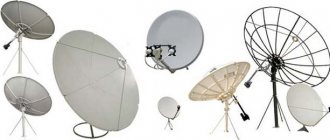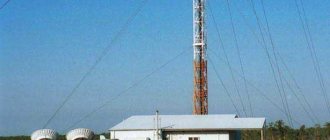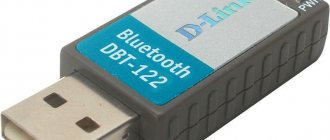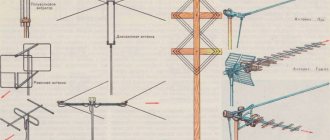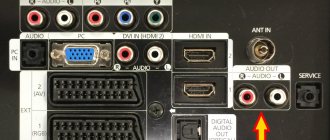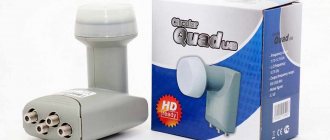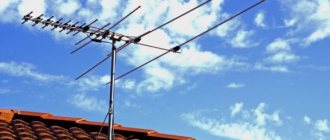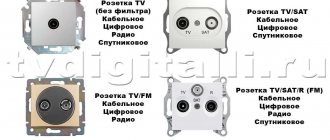The first and most important advantage of using satellite dishes is the ability to view a large number of channels in high quality in the most remote corners of the country.
Also, the advantages of choosing a so-called dish antenna include the possibility of a wide selection of different channels, but terrestrial or cable television broadcasts only what the majority of viewers watch.
Important things to know about television
Satellite television works on the same principle as other broadcast formats.
A radiation wave of a certain length is sent from the broadcaster, thereby broadcasting at a specific frequency. To watch television, the user also needs a receiver that receives the signal and transports it through the cable to the image output device. It uses satellite dishes.
The television repeater is a satellite placed in geostationary orbit. It transmits a signal in the frequency range from 0.3 to 3 GHz.
Due to the long distance and passage of dense layers of the atmosphere, only high-frequency radiation can reach the Earth's surface and arrive at the user's receiver.
Reception area
A receiving area is the area on Earth where you can pick up a signal from a particular satellite. The satellite sends signals to Earth with its transmitting antenna, and due to the distance, the beam increases and a circle is formed. It's similar to how a flashlight shines in the dark - the further you are from the flashlight, the larger the circle of light on the wall, although the light bulb itself is small.
To cover the entire territory of the country with such areas, for example, you need several satellites, each of which will be responsible for its own area. Coverage areas can overlap without interfering with each other, because each satellite encodes the signal at its own frequency. The closer to the center of the satellite's coverage area, the better the connection.
Advantages
The main advantage of the technology is global broadcasting over a large area. This allows TV companies to quickly roll out broadcasts to a large number of users. The radiation arrives perpendicular to the plane of the earth, eliminating the problem of super-dense buildings and terrain features. Satellite TV works ideally in mountainous areas and large cities.
It is also available to the user in any social setting. Even in areas with a complete lack of infrastructure, it is always possible to install a satellite dish to receive a signal.
General characteristics
What is included in the equipment set:
- Converter. The head, the active component of the antenna, receives the incoming signal.
It is possible to install several heads of different operators on one antenna. - Plate. Serves as a reflector to redirect the wave to the converter. At high frequencies, a large flow of short-wave radiation occurs, partially passing through the head, the plate reflects it and returns it to the converter.
- Receiver. It is used to decrypt a digital signal of the DVB-S/S2 standard and display the image on the screen in its usual form. Unlike other television formats, a receiver is always needed when connecting. It serves as a carrier for thousands of physical channels that even a Smart TV does not have.
- CAM module. It is required for activation using a satellite television payment card supplied by the provider.
- Mounting kit for equipment assembly.
A converter with a dish are the main components of a satellite antenna, which will be discussed in more detail below.
Technical description
Satellite television is a broadcast signal that is transmitted to viewers’ screens using a complex of satellites that orbit the Earth.
Due to the fact that the need for telecommunications is increasing every year, terrestrial broadcasters have ceased to fully cope with their functions.
They are not capable of supporting signal transmission over long distances, and one could completely forget about relaying overseas. An equally important disadvantage of older formats is the instability of image and sound quality. Thus, devices located at a relatively close distance to the source receive the information flow better, as a result of which the level of picture and audio varies greatly. Satellite TV is a great alternative to more outdated broadcast technologies. This way the quality of broadcasting is maintained at a high level.
The main advantage is low energy consumption. So the satellite rotates in orbit following the planet without wasting extra resources, and the power source is solar panels, the power of which is completely sufficient to maintain the operation of space equipment.
The coverage of the territory is quite large; the signal can easily cover up to a quarter of the surface of the entire planet.
Broadcasting can be done in two different ways:
- Direct television broadcasting is the simplest and most accessible. This way the video signal goes directly to the viewer, eliminating intermediaries.
- Retransmission using terrestrial television centers - first the information reaches one specific point, after which it spreads further with the help of antennas until it reaches the consumer.
Coverage of the territory of the Russian Federation with an MTS satellite signal.
The type of broadcasting depends on the operator you initially chose. If you are not satisfied with any of the above options, then you can safely refuse the services of this provider and switch to the type of broadcast that will be convenient for you personally.
Converter
The device receives a high-quality signal only with direct reception and the converter must be aimed exactly at the satellite. Otherwise, reception is still possible, but there will be obvious interference in cloudy weather.
Each head works according to a different principle, on which the type of antenna itself depends:
- TV receiver. Its head works to receive a broadcast signal and transmit it via cable. With its help, operators supply television to the user. Several heads of different operators can be attached to one dish. The heads are capable of receiving ATV and DTV. Depending on the standard of the broadcast being received, the cable from the antenna is connected directly to the TV or through the receiver.
- Data transmitter. Such an antenna can not only receive, but also transmit a signal, exchanging data with a satellite. Its device is more complex and the cost is higher. The antenna head is used for satellite communications, provides television and Internet access, and also allows the user to broadcast on television and radio.
Both types of converters are made of conductive material. As protection from the external environment, the head is additionally covered with an insulating casing or a cover is put on.
Material of manufacture
The main task of the dish surface is to reflect waves received from the satellite, but the antenna will always be outdoors, so it must be resistant to all negative influences of the external environment. The following materials are used to make satellite dishes:
- aluminum - the most interesting option. The material is lightweight and resistant to corrosion. Due to their light weight, such dishes have poor resistance to winds and mechanical damage, therefore, to prevent the antenna from being blown away, reinforced mounts must be used;
- steel. Such a plate will cost less than an aluminum one, but it weighs more, which will complicate installation. Steel products are susceptible to corrosion, so pay attention to the quality of the protective layer;
- plastic plates with metal coating appeared not so long ago, but have not yet taken root. The main advantage is low weight, hence the ease of installation. The disadvantages include high price, low durability and poor performance. Moreover, in winter snow sticks well to plastic;
- worth highlighting separately mesh metal antennas. They are designed for installation at high altitudes, as well as in regions with frequent and strong winds. Numerous slots reduce windage, so the antenna will not be carried away. The feature of the dish does not affect the quality of the signal in any way. The downside is the higher cost compared to analogues.
Plate (reflector)
Wave radiation tends to scatter, but this happens already on the final path from the satellite - in the dense layers of the atmosphere. The reflector ensures guaranteed signal absorption by the converter, focusing the already scattered radiation passing by it.
The plates should preferably be white, because... it guarantees complete reflection of the emitted wave.
The area of signal scattering depends on the thickness of the dense layers. In each region, the territory is at a different level above the sea.
In mountainous areas, the thickness of the air masses is thinner and the dispersion occurs weaker; in the opposite case, on the contrary, the signal is dissipated to the maximum.
In view of this factor, for high-quality reception of broadcasts from the satellite, a reflector of different diameters is installed. Satellite dishes as small as 0.6m are suitable for most areas, but some locations will require up to 1.5m. Connected without a dish will not show (DTV) or will display an image with strong noise (ATV)
Common connection errors
If, after installing the equipment, the image leaves much to be desired, it means that errors were made during setup, which led to a deterioration in the quality of signal reception. In most cases, users make the following mistakes:
- insufficient diameter of the antenna mirror - leads to loss of signal in bad weather conditions;
- errors when choosing the polarization of the converter - do not allow the equipment to tune to the desired satellite;
- lack of a protective casing - at low temperatures the irradiator will become covered with ice;
- connection via an unsuitable cable - the core must be copper: a steel core noticeably worsens the reception quality;
- poor-quality cable crimping at the connection points.
In addition, most users make mistakes when connecting two or more TVs to a satellite dish.
If you are not confident in your abilities, you should not install the equipment yourself. In the best case, specialists called to fix the malfunction will require partial compensation for the cost of damage; in the worst case, the repair is completely carried out at the user’s expense.
Antenna installation location
The signal from the satellite arrives vertically to the receiver. If a concrete structure is located in the path, the radiation will be reflected and directed into the airspace, after which it will dissipate completely. If the signal is not received, the earth will partially or completely absorb it.
This is due to the physical properties of wave radiation, which is absorbed by a black body and reflected from a light surface.
Based on this, it is possible to receive only a direct signal, because The radiation reflected by the structure is moved away from the user, and reception from the ground is impossible. Therefore, installation of the antenna is only possible outdoors and with an exact direction to the satellite. There should be no major obstacles between it and the converter.
In sparsely populated areas, the installation site for television can be the frame of a private house or a pole. In urban areas, installation is carried out on the roof, less often on the facade (upper floors) of apartment buildings.
The user can continue to use a regular terrestrial indoor antenna for home TV. It should be taken into account that the receiver of the kit is not designed for decoding DVB-T2 and different set-top boxes will be required.
Satellite dishes. From A to Z"
In this article we will describe the principle of operation of a satellite dish, and also give practical advice on its selection depending on the user’s needs. Satellite signals are quite weak. But what is especially noteworthy is the fact that we can receive these signals using satellite antennas, the cost of which today ranges from 125 UAH. If you want to get maximum performance from your receiving system, you must select the correct model and size of your receiving antenna.
What does the plate consist of?
The process of receiving a satellite television signal can be divided into two stages. At the first stage, the television signal is captured and focused at one point. In this case, it is necessary that this signal be of as large an amplitude as possible. At the second stage, the signal is amplified and processed. The main purpose of a satellite dish is to pick up television signals. Typically, a satellite dish has a dish-shaped reflector. At the same time, it must be an ideal parabolic shape and not deform over years of operation, as well as during transportation and installation. A dish that is dented, bent, or otherwise deformed will not be able to fully focus the signal because some of the data will be lost and the resulting signal will be too weak to be converted into an image. Usually the reflector is made of metal (steel, since it is the cheapest metal, or aluminum, since it does not corrode). In this case, the surface of the antenna can be either solid or perforated. Perforated antennas do not reflect sunlight and have low wind load. In addition, they have less mass, and in terms of reflectivity they are almost as good as their solid metal “relatives”. Other materials are also used to make satellite antennas, such as plastic, polymer and fiberglass. Such antennas are easy to manufacture, lightweight, do not corrode, and completely restore their shape after deformation is removed. The satellite signal penetrates these materials and is easily reflected from the thin layer of foil or metal mesh built into the antenna. A low-noise monoblock converter (LNB), located in the center of the antenna, processes and converts the received signal. Next, depending on the polarization and frequency band, the signal is selected, after which the weak signal is amplified and converted into a low-frequency signal for its subsequent transmission via cable to the input of the satellite receiver.
Noise and decibels
The signal received by the antenna converter (LNB) contains virtually no electrical noise. However, when passing through the electronic components of the equipment, noise is superimposed on the signal. To prevent a weak satellite signal from being drowned out by noise, the antenna converter's own noise levels must be low.
Universal Ku-band satellite converter with one independent output for receiving signals in linear polarization with a noise level of up to 0.2 dB, designed for offset antennas
“Noise figure” characterizes the noise level of the converter and is measured in decibels (dB). This is the ratio of the output noise level to the input noise level. It is worth considering that the “noise factor” has a nonlinear dependence, and its increase by 3 dB means a twofold increase in the noise amplitude. Over the past ten years, converters have been greatly improved. Their noise figure was reduced from 1.8 dB to 0.3 dB (not taking into account the clearly inflated data mentioned on the market), and their cost was reduced by three to five times. Most likely, in Ukraine, new “satellite viewers” will purchase a set for viewing from three satellites (Amos+Astra+HotBird). In this case, converters with a noise figure of 0.3 dB are usually used. But if you are an enthusiast and plan to receive weak and unstable signals, then in this case you should purchase a converter with the lowest possible noise figure, since such options are available on the Ukrainian market.
Offset (asymmetric) satellite dish
Will any plate work?
The sizes and shapes of plates can vary greatly. Plates of older models were produced in a round shape, and the converter was mounted in the center on three legs (the so-called direct focus design). However, now most plates have an offset design in the form of an oval, in the lower part of which there is a supporting rod, on which a multifeed or one converter is mounted. In such antennas, the converter is located away from the signal path, and rainwater or snow does not accumulate on the reflector, unlike direct-focus antennas. Conventional, as well as amateur, antennas are distinguished by a taller shape, but they are not very wide. But the mini-dishes that are used today to receive signals from many European operators (for example, BSkyB, Canal Plus, Freesat), on the contrary, are wider and have a smaller height. The larger the dish is horizontally, the better it is tuned to one of the satellites located close to each other (the larger the dish, the smaller its reception angle).
Direct focus satellite dish. The photo clearly shows the accumulation of snow on the mirror.
Why does size matter?
No matter what shape of plate you choose, the key parameter is its size. It is the size that characterizes the ability of the dish to receive a signal. If the converter receives a signal of insufficient amplitude, you will not receive an image on the screen. In addition, a signal that is too weak cannot be amplified using a converter amplifier, since it will only amplify the noise and will not ensure normal operation of the system. Therefore, with a weak signal, nothing can replace a large antenna. Every centimeter in the diameter of the antenna is important, because with an increase in diameter by 40%, the signal amplitude doubles. For example, a dish with a diameter of 1.2 meters produces a signal with one and a half times greater amplitude than a dish with a diameter of 1 meter. To make sure that the diameter of the antenna you choose is sufficient, you should know the approximate level of the satellite signal near its installation site.
Reception areas
Satellites transmit signals of varying amplitudes and powers, covering different areas of the earth's surface. Even if you are within satellite coverage, it is still important to know the signal strength near your home. It is impossible to accurately predict the signal strength of a particular satellite. However, the approximate signal level can be found using special signal level maps. These maps are also called coverage maps and provide approximate signal levels based on installation location. And although the signal can be received outside the satellite coverage area, it will be significantly weakened. And the farther the receiving antenna is installed from the center of the satellite coverage area, the weaker the received signal will be.
Satellite coverage maps indicate either the required minimum dish size or the equivalent isotropically radiated power (EIRP), which is measured in decibels per watt (dBW) and characterizes the signal strength. The conversion table for these two quantities is given below.
Signal level depending on antenna diameter
| EIRP (dBW) | Antenna diameter (cm) |
| 35 | 300 |
| 40 | 180 |
| 42 | 160 |
| 44 | 120 |
| 46 | 95 |
| 48 | 75 |
| 50 | 60 |
| 51 | 55 |
| 52 | 50 |
| 53 | 45 |
| 54 | 40 |
Satellite dishes of other geometric shapes
Although offset and direct-focus antennas are the most popular in Ukraine today, there are other types in nature. Throughout the history of satellite television, various modifications of satellite antennas have been tried (and they are still in use). Some antenna modifications use an auxiliary reflector to more effectively focus the signal onto the converter. The shape of the auxiliary reflector can be concave - like the shape of the main reflector (Gregorian design), or curved (Cassegrain design). Antennas with two reflectors have greater performance, are characterized by lower levels of cross-polarization interference and noise, and also have smaller dimensions. And although the two-mirror design is almost always used for large antennas of communication systems, it is practically not used for the manufacture of “home” dishes. And, for example, in antennas in the form of a flat plate there are no reflectors at all. In terms of size/performance ratio, it is superior to dish-shaped antennas, and if its cost can be reduced, it can become the “antenna of the future” for home use. In the meantime, offset antennas hold the palm in our market.
Advantages and disadvantages
As discussed above, an antenna receiving a signal from a satellite has two advantages - global coverage and connection in the absence of infrastructure or the inability to receive a high-quality signal from a terrestrial repeater.
However, these are only superficial benefits, followed by other qualities:
- Reception of a huge number of channels. The antenna receives signals in the frequency range from 1 GHz to 3 GHz.
- High throughput. Satellites can transmit data in any format, including a digital signal for Full-HD broadcasting or an Internet connection.
- View from any device. All reception and decryption functions are performed by the kit.
The only downside is the outdoor installation of the antenna, which is expensive. Also, users in some regions may encounter the problem that a particular provider does not have a set of the required dish diameter.
In this case, the reflector and fastening elements will need to be purchased separately.
Advice! If the operator has a dish of the required size for the antenna, it is better to purchase the entire set from him. Such a purchase will be more profitable than purchasing each device separately.
It is better to order the installation of a satellite dish in a store or from a specialist, and you can do the setup on the TV yourself.
To do this you need:
- Connect the antenna cable from the converter to the receiver.
- Connect the receiver to the TV using an RCA or hdmi connector.
- Switch the TV to the physical channel corresponding to the socket to which the receiver is connected.
- Activate the television (check with your operator for details).
- Select satellite and modulation values (64 or 256 QAM for S or S2 standard, respectively).
- Enable automatic channel search.
Attention! If one of the converters, which broadcasts only ATV, is connected directly to the TV, bypassing the receiver, its programs will be placed on the physical channels of the TV.
Consequently, their search will lead to the deletion of existing terrestrial TV channels. To avoid this, you need to manually configure each program.
If a VHF antenna is currently connected, you can simplify the process - first perform an auto search for digital ones, and then manually tune in terrestrial TV channels, of which there are much fewer.
What equipment is needed to install satellite TV and Internet
The consumer can easily purchase the necessary equipment sets for satellite TV from different satellite TV and Internet operators, which come in different levels of configuration. The main difference is the price. You should be careful when choosing, because not every set may meet your requirements. If you can’t decide, then you should ask for help from a person who understands this issue. He will select the necessary model for you, without unnecessary problems.
- Incomplete set : includes a receiver, a module with an access card and all the documentation necessary for the user. This option is the most economical of all possible, but it lacks many of the necessary elements that you will need to install and configure satellite television. It is worth purchasing if you already have the elements you need at your disposal.
- Complete kit : it includes all the necessary components, such as; receiver, antenna, converter, module, cables and all documentation. This set is completely self-contained and does not require extra costs for additional parts. If you have never used satellite television before, then this will be quite enough for you.
- Expanded set : completely corresponds to the contents of the previous one, but as an addition there is a second receiver. You can use it to connect a second TV. This set is ideal for a large family, so that all its members can enjoy watching their favorite programs in good quality, without the risk of missing any important moment or having to wait their turn.
A set of equipment for connecting satellite TV - a receiver, a set of cables, brackets and fittings for installing a dish antenna, a signal converter, the antenna itself, Dysik, heads
